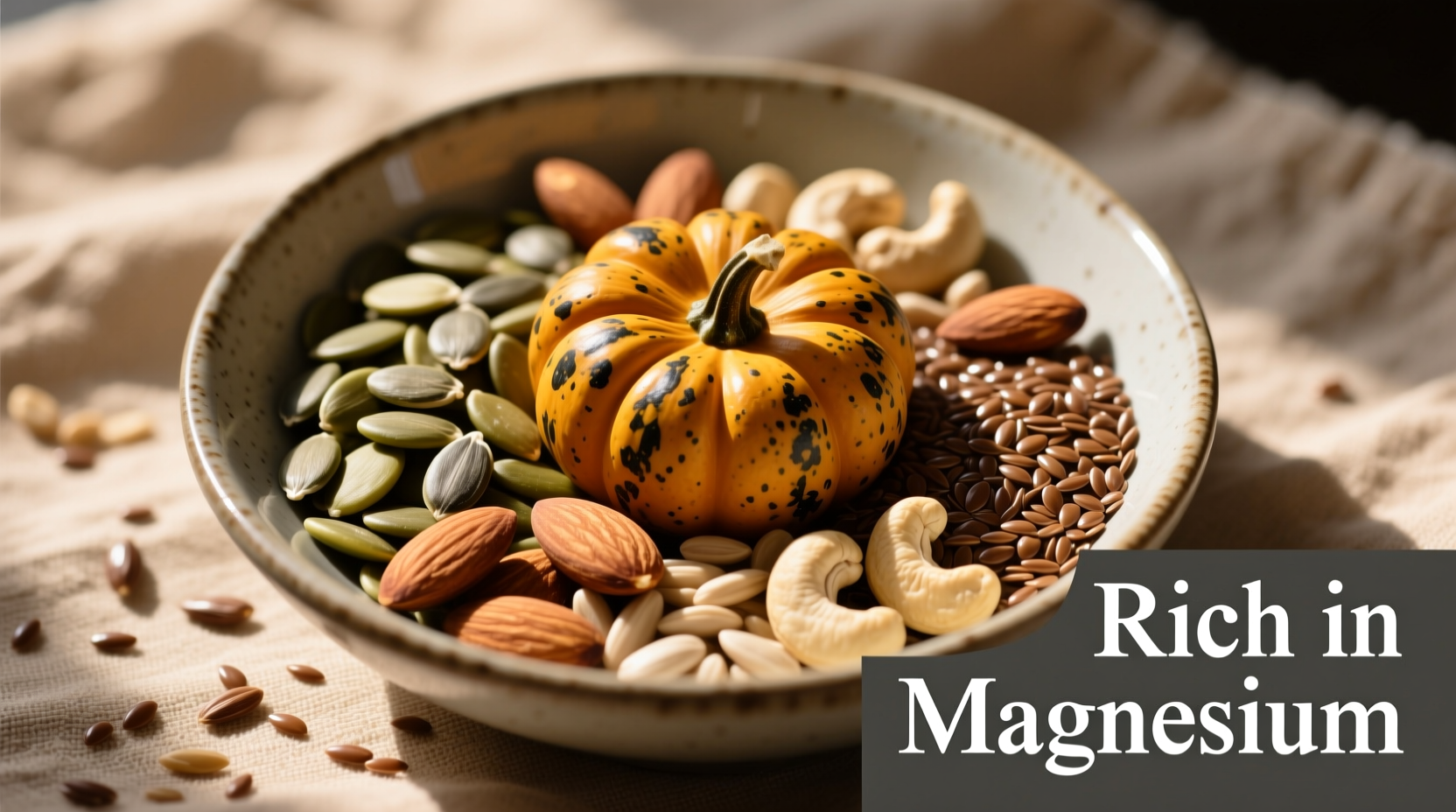Top Magnesium Powerhouse Foods: The Definitive Ranking
When searching for what food is highest in magnesium, the answer becomes clear through scientific analysis of nutritional data. Based on USDA FoodData Central measurements, here's the definitive ranking of magnesium-rich foods that should form the foundation of your mineral-rich diet:
| Food | Serving Size | Magnesium (mg) | % Daily Value |
|---|---|---|---|
| Pumpkin seeds | 1 ounce (28g) | 156 | 37% |
| Chia seeds | 1 ounce (28g) | 111 | 26% |
| Almonds | 1 ounce (23 whole) | 80 | 19% |
| Spinach (cooked) | 1 cup | 78 | 18% |
| Black beans | 1 cup | 120 | 28% |
| Avocado | 1 medium | 58 | 14% |
| Dark chocolate (70-85%) | 1 ounce (28g) | 64 | 15% |
According to the USDA FoodData Central, pumpkin seeds consistently rank as the magnesium champion among commonly consumed foods. Just a quarter-cup serving provides nearly half your daily requirement. What makes this particularly valuable is that pumpkin seeds deliver magnesium in a highly bioavailable form, meaning your body can readily absorb and utilize this essential mineral.

Why Magnesium Matters: Beyond Basic Nutrition
Magnesium isn't just another mineral—it's a cofactor in more than 300 enzymatic reactions in your body. The NIH Office of Dietary Supplements identifies magnesium as critical for energy production, protein formation, muscle function, and nervous system regulation. Despite its importance, research shows that nearly half of Americans don't meet the recommended daily intake of 400-420mg for men and 310-320mg for women.
What many people searching for what food is highest in magnesium don't realize is that magnesium deficiency can manifest in subtle ways: muscle cramps, fatigue, irregular heartbeat, and even sleep disturbances. The good news? Incorporating magnesium-rich foods can help address these issues naturally.
Maximizing Magnesium Absorption: What Most Guides Miss
Simply knowing what food is highest in magnesium isn't enough—you need to understand how to optimize absorption. Magnesium bioavailability varies significantly based on several factors:
- Fiber content: While fiber is healthy, very high-fiber foods can slightly reduce magnesium absorption
- Phytates: Found in whole grains and legumes, these can bind magnesium but proper preparation (soaking, sprouting) reduces this effect
- Vitamin D status: Adequate vitamin D significantly enhances magnesium absorption
- Calcium intake: Extremely high calcium can compete with magnesium for absorption
Interestingly, the Mayo Clinic notes that magnesium absorption improves when consumed with protein-rich foods. This explains why pairing pumpkin seeds with Greek yogurt creates a more effective magnesium-boosting snack than eating seeds alone.
Practical Incorporation Strategies for Daily Magnesium Boost
Understanding what food is highest in magnesium becomes truly valuable when you can easily integrate these foods into your routine. Here are practical, research-backed strategies:
Morning Magnesium Boost
Add one tablespoon of chia seeds (72mg magnesium) to your morning smoothie or oatmeal. The soluble fiber in chia actually enhances magnesium absorption when combined with vitamin C-rich fruits like strawberries.
Lunchtime Power
Create a spinach and black bean salad (198mg magnesium per serving). The vitamin C in tomatoes and bell peppers significantly increases magnesium absorption from the spinach—demonstrating how smart food combinations maximize nutrient uptake.
Afternoon Snack Solution
Enjoy a small handful of almonds (80mg magnesium) with a square of dark chocolate. This combination not only provides magnesium but also delivers healthy fats that further enhance mineral absorption.
Dinner Enhancement
Sprinkle pumpkin seeds over roasted vegetables. The heat from cooking doesn't degrade magnesium, making this an excellent way to boost your evening intake without altering flavors significantly.
Special Considerations for Optimal Magnesium Intake
While focusing on what food is highest in magnesium is valuable, certain populations need special attention:
- Athletes: Endurance exercise increases magnesium loss through sweat—consider increasing intake by 10-20%
- Older adults: Magnesium absorption decreases with age, making dietary density even more crucial
- Vegans and vegetarians: While plant-based diets are naturally rich in magnesium, proper food preparation techniques are essential to maximize bioavailability
- Medication users: Certain medications (like proton pump inhibitors) can reduce magnesium absorption
It's worth noting that while pumpkin seeds top the list for magnesium density, they're also calorie-dense. For those monitoring calorie intake, spinach and black beans offer excellent magnesium-to-calorie ratios—delivering substantial magnesium with fewer calories per serving.
When Food Sources Aren't Enough
For most people, focusing on what food is highest in magnesium provides sufficient intake. However, certain medical conditions (like Crohn's disease, celiac disease, or type 2 diabetes) can impair magnesium absorption. In these cases, consult with a healthcare provider about potential supplementation needs.
Remember that magnesium works synergistically with other nutrients—particularly calcium, potassium, and vitamin D. Rather than focusing solely on magnesium, aim for a balanced approach that supports overall mineral harmony in your body.











 浙公网安备
33010002000092号
浙公网安备
33010002000092号 浙B2-20120091-4
浙B2-20120091-4